| Coronary
Artery Bypass Surgery
What is coronary artery bypass graft
(CABG) surgery?
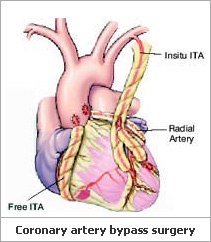 Coronary
artery bypass graft surgery is a form of cardiac bypass
surgery in which one or more blocked coronary arteries
are bypassed by a blood vessel graft to restore normal
blood flow to the heart. These grafts usually come
from the patient's own arteries and veins located
in the chest, leg, or arm. The graft goes around the
clogged artery (or arteries) to create new pathways
for oxygen-rich blood to flow to the heart. Coronary
artery bypass graft surgery is a form of cardiac bypass
surgery in which one or more blocked coronary arteries
are bypassed by a blood vessel graft to restore normal
blood flow to the heart. These grafts usually come
from the patient's own arteries and veins located
in the chest, leg, or arm. The graft goes around the
clogged artery (or arteries) to create new pathways
for oxygen-rich blood to flow to the heart.
The goals of the cardiac bypass surgery are to relieve
symptoms of coronary artery disease (including angina),
enable the patient to resume a normal lifestyle and
to lower the risk of a heart attack or other heart
problems.
Who is eligible to receive coronary
artery bypass graft surgery?
The decision to prescribe medical
treatment, invasive procedures or cardiac bypass surgery
depends on several factors including the extent of
cardiovascular disease, the severity of symptoms,
your age and other medical conditions. The cardiologist
(heart specialist) and surgeon will determine the
best method of therapy for each patient.
What happens during the surgery?
The surgery generally lasts from
three to five hours, depending on the number of arteries
being bypassed.
Surgical Procedure
During traditional CABG surgery,
a surgeon makes an incision down the center of the
chest, cuts through the sternum (breastbone), and
retracts the ribcage to get direct access to the heart.
During surgery, the heart-lung bypass machine (called
"on-pump" surgery) is used to take over
for the heart and lungs during surgery, allowing the
circulation of blood throughout the rest of the body.
The heart's beating is stopped so the surgeon can
perform the bypass procedure on a "still"
heart.
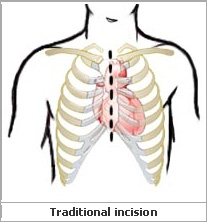 Traditional
coronary artery bypass graft (CABG) surgery Traditional
coronary artery bypass graft (CABG) surgery
During traditional CABG, a surgeon
will make an incision down the center of your sternum
(breastbone), to get direct access to your heart.
You are connected to the heart-lung bypass machine
which allows the circulation of blood throughout the
body during surgery. The heart is stopped and the
surgeon then performs the bypass procedure. After
surgery, the surgeon closes the breastbone with special
sternal wires and the chest with special internal
or traditional external stitches.
Minimally invasive coronary artery
bypass (MIDCAB) surgery
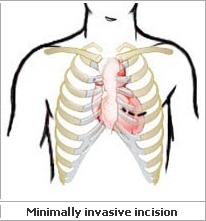 Your
surgeon will review your diagnostic tests prior to
your surgery to see if you are a candidate for minimally
invasive bypass surgery. Your
surgeon will review your diagnostic tests prior to
your surgery to see if you are a candidate for minimally
invasive bypass surgery.
Minimally invasive bypass surgery can be performed
through a small thoracotomy incision for patients
that require a LIMA graft to the LAD.
Newer robotic techniques are allowing surgeons to
perform bypass surgery through even smaller keyhole
incisions.
The benefits to minimally invasive
bypass surgery include
- Smaller incision - smaller scar
- Shorter hospital stay - in some cases, only 3
days are needed (instead of the average 5 - 6 days
for traditional surgery)
Other benefits may include
- Shorter recovery time
- Less bleeding
- Less potential for infection
- Less pain and trauma
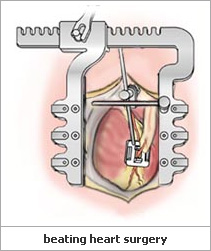 Off-pump
or beating heart bypass surgery Off-pump
or beating heart bypass surgery
Off-pump or beating heart bypass
surgery allows surgeons to perform surgery on the
heart while it is still beating. The heart-lung machine
is not used. The surgeon uses advanced operating equipment
to stabilize (hold) portions of the heart and bypass
the blocked artery in a highly controlled operative
environment. Meanwhile, the rest of the heart keeps
pumping and circulating blood to the body.
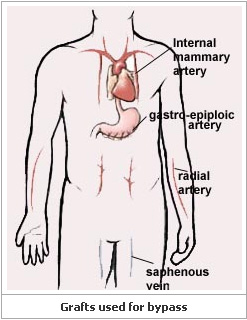 Bypass
Grafts Bypass
Grafts
There are several types of bypass
grafts that can be used. These types of blood vessels
can be used because there are other pathways that
take blood to and from the tissues of your chest,
arms, and legs. The surgeon decides which graft(s)
to use depending on the location of blockage, the
amount of blockage, and the size of your coronary
arteries.
Internal mammary arteries (also called
thoracic arteries, IMA grafts)
These are the most common bypass
grafts used, as they have been shown to have the best
long-term results. In most cases, these arteries can
be kept intact at their origin, then sewn to the coronary
artery below the site of blockage because they have
their own oxygen-rich blood supply. If the surgeon
removes the mammary artery from its origin, it is
then called a "free" mammary artery. Over
the last decade, more than 90% of all patients received
at least one internal artery graft.
Surgeons use arteries more than
veins to bypass narrowed coronary arteries. This is
done because the arteries do not close nearly as quickly
after surgery as do the veins, which have traditionally
been used to bypass arteries of the heart.
Radial artery
The radial artery is the second
most common type of arterial graft. There are two
arteries in the arm, the ulnar and radial arteries.
Most people receive blood to their arm from the ulnar
artery and will not have any side effects if the radial
artery is used. Careful preoperative and intraoperative
tests determine if the radial artery can be used.
If you have certain conditions (such as Raynaud's,
carpal tunnel syndrome or painful fingers in cold
air) you may not be a candidate for this type of bypass
graft. The radial artery incision is in your forearm,
about 2 inches from your elbow and ending about 1
inch from your wrist. After this type of bypass, patients
are routinely placed on a medication called a "calcium
channel blocker" for about 6 months after surgery
to help keep the radial artery widely open.
The gastroepiploic artery to the
stomach and the inferior epigastric artery to the
abdominal wall are less commonly used for grafting.
After Surgery
If the procedure was done "on
pump," electric shocks start the heart pumping
again after the grafts have been completed. The heart-lung
machine is turned off and the blood slowly returns
to normal. Pacing wires and a chest tube to drain
fluid are placed before the sternum is closed surgically
with special sternal wires and the chest with special
internal or traditional external stitches. Sometimes
a temporary pacemaker is attached to the pacing wires
to regulate the heart rhythm until your condition
improves.
The patient is transferred to an
intensive care unit for close monitoring for about
one to two days after the surgery. The monitoring
during recovery includes frequent checks of vital
signs and other parameters, such as heart sounds and
oxygen and carbon dioxide levels in arterial blood.
Once the patient is transferred
to the nursing unit, the hospital stay is about 3
to 5 more days.
Recovery
Full recovery from coronary artery
bypass graft surgery takes two to three months. Most
patients are able to drive in about three to eight
weeks after surgery. Sexual activity can be resumed
in three to four weeks, depending on your rate of
recovery. Most people with sedentary jobs can go back
to work in four to six weeks after surgery; people
with more physical jobs (such as construction workers
or jobs requiring heavy lifting) may have to wait
up to twelve weeks before returning to work. Your
doctor will provide specific guidelines for your recovery
and return to work, including specific instructions
on how to care for your incision and general health
after the surgery.
Amazon will work with you and our India
Affiliates to create a package where all your Cardiac
concerns/problems can be addressed. If you have any
questions, please do not hesitate to contact us by
phone or email.
|